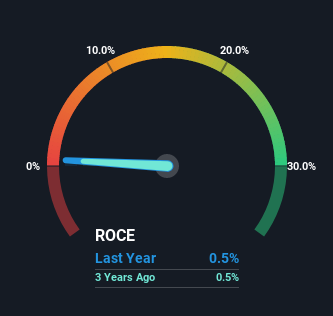- United States
- /
- Hospitality
- /
- NasdaqGS:PBPB
The Returns On Capital At Potbelly (NASDAQ:PBPB) Don't Inspire Confidence
If you're looking for a multi-bagger, there's a few things to keep an eye out for. Firstly, we'd want to identify a growing return on capital employed (ROCE) and then alongside that, an ever-increasing base of capital employed. Put simply, these types of businesses are compounding machines, meaning they are continually reinvesting their earnings at ever-higher rates of return. In light of that, when we looked at Potbelly (NASDAQ:PBPB) and its ROCE trend, we weren't exactly thrilled.
Understanding Return On Capital Employed (ROCE)
If you haven't worked with ROCE before, it measures the 'return' (pre-tax profit) a company generates from capital employed in its business. To calculate this metric for Potbelly, this is the formula:
Return on Capital Employed = Earnings Before Interest and Tax (EBIT) ÷ (Total Assets - Current Liabilities)
0.0054 = US$950k ÷ (US$245m - US$69m) (Based on the trailing twelve months to December 2022).
Thus, Potbelly has an ROCE of 0.5%. In absolute terms, that's a low return and it also under-performs the Hospitality industry average of 10%.
View our latest analysis for Potbelly

In the above chart we have measured Potbelly's prior ROCE against its prior performance, but the future is arguably more important. If you're interested, you can view the analysts predictions in our free report on analyst forecasts for the company.
What Can We Tell From Potbelly's ROCE Trend?
In terms of Potbelly's historical ROCE movements, the trend isn't fantastic. To be more specific, ROCE has fallen from 8.0% over the last five years. Although, given both revenue and the amount of assets employed in the business have increased, it could suggest the company is investing in growth, and the extra capital has led to a short-term reduction in ROCE. If these investments prove successful, this can bode very well for long term stock performance.
On a side note, Potbelly's current liabilities have increased over the last five years to 28% of total assets, effectively distorting the ROCE to some degree. Without this increase, it's likely that ROCE would be even lower than 0.5%. Keep an eye on this ratio, because the business could encounter some new risks if this metric gets too high.
What We Can Learn From Potbelly's ROCE
In summary, despite lower returns in the short term, we're encouraged to see that Potbelly is reinvesting for growth and has higher sales as a result. However, despite the promising trends, the stock has fallen 20% over the last five years, so there might be an opportunity here for astute investors. As a result, we'd recommend researching this stock further to uncover what other fundamentals of the business can show us.
On a separate note, we've found 2 warning signs for Potbelly you'll probably want to know about.
While Potbelly may not currently earn the highest returns, we've compiled a list of companies that currently earn more than 25% return on equity. Check out this free list here.
New: Manage All Your Stock Portfolios in One Place
We've created the ultimate portfolio companion for stock investors, and it's free.
• Connect an unlimited number of Portfolios and see your total in one currency
• Be alerted to new Warning Signs or Risks via email or mobile
• Track the Fair Value of your stocks
Have feedback on this article? Concerned about the content? Get in touch with us directly. Alternatively, email editorial-team (at) simplywallst.com.
This article by Simply Wall St is general in nature. We provide commentary based on historical data and analyst forecasts only using an unbiased methodology and our articles are not intended to be financial advice. It does not constitute a recommendation to buy or sell any stock, and does not take account of your objectives, or your financial situation. We aim to bring you long-term focused analysis driven by fundamental data. Note that our analysis may not factor in the latest price-sensitive company announcements or qualitative material. Simply Wall St has no position in any stocks mentioned.
About NasdaqGS:PBPB
Potbelly
Owns, operates, and franchises Potbelly sandwich shops in the United States.
Adequate balance sheet with moderate growth potential.
Similar Companies
Market Insights
Community Narratives




